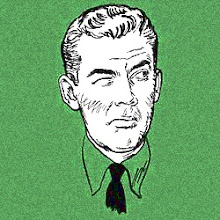 On May 6, Eisenhower signed into law The Civil Right Act of 1960, which did no more or less than establish federal inspection of local registration polls and create penalties for people who prevented a citizen registering to vote. (In the 1960 election, despite this new law and a civil rights bill passed in 1957, only an additional 3% of African American voters were added to the electorate.)
On May 6, Eisenhower signed into law The Civil Right Act of 1960, which did no more or less than establish federal inspection of local registration polls and create penalties for people who prevented a citizen registering to vote. (In the 1960 election, despite this new law and a civil rights bill passed in 1957, only an additional 3% of African American voters were added to the electorate.)The real story of the 1960 act was what happened in Congress. LBJ, majority leader, prevented 18 southern Democrats from killing the bill by filibuster (they each took four-hour stints jabbering on the floor). He outlasted them procedurally and psychologically. John instigated round-the-clock sessions. He also had 40 army cots with bedding moved into Senate offices to ensure that 51 senators could be rounded up at any moment for an emergency quorum call. Eventually the Republicans--the Republicans--with an eye on the upcoming election, wanted some kind of civil rights bill passed that spring. LBJ worked with Eisenhower's attorney general, William P. Rogers (same man who was later Nixon's Secretary of State, the guy bypassed by Kissinger), to come up with a compromise bill, and that's the modest bill that was eventually passed.
LBJ was called "the southern Benedict Arnold" by the Florida Times-Union.
When it was done it had been the longest filibuster in history, lasting for 43 hours from February 29 to March 2. Johnson made sure that the bill was intact even after such a long "debate."
Above is the famous sequence of "Johnson treatment" photos taken for the New York Times.

 Is '60 the moment when the end of the end of the Old Left had been reached and the New Left began to emerge? Is it the final ascendancy, in certain scenes at least, of poetic postmodernity? Surely the publication of Donald Allen's The New American Poetry that year suggests this, but then again--once again--we look back on "New" here and see continuity. The rhetoric of the Kennedy-Nixon contest made much less of a dent than everyone (at the time as well as since) claimed, so one wonders why were such great claims made?
Is '60 the moment when the end of the end of the Old Left had been reached and the New Left began to emerge? Is it the final ascendancy, in certain scenes at least, of poetic postmodernity? Surely the publication of Donald Allen's The New American Poetry that year suggests this, but then again--once again--we look back on "New" here and see continuity. The rhetoric of the Kennedy-Nixon contest made much less of a dent than everyone (at the time as well as since) claimed, so one wonders why were such great claims made?  Had we come to expect "1960" to be truly ubiquitously modern in a way that the 1950s really were not--not quite? And what specifically does "modern" mean in the Kennedyesque talk then and now about the torch being passed to a new generation, etc.? The First Lady really meant "modernist" when Camelotians said "modern." What about the others across the new young cultural leadership? I've been surprised by how frequently the
Had we come to expect "1960" to be truly ubiquitously modern in a way that the 1950s really were not--not quite? And what specifically does "modern" mean in the Kennedyesque talk then and now about the torch being passed to a new generation, etc.? The First Lady really meant "modernist" when Camelotians said "modern." What about the others across the new young cultural leadership? I've been surprised by how frequently the  "Beat movement" was covered in 1960 in the mainstream press. I was expecting a fair measure but I've found tonnage. 1960 was the year when the figure of the beat was beginning to find acceptance, although still 80% of these stories are mocking, rebels-without-cause condescension. For anyone whose analysis made an impact nationally, do these antipolitical adolescents count as part of the "new young cultural leadership"? No, but rather than the two being opposites, they fall along a Continuum of the New American. Now that's a change for '60.
"Beat movement" was covered in 1960 in the mainstream press. I was expecting a fair measure but I've found tonnage. 1960 was the year when the figure of the beat was beginning to find acceptance, although still 80% of these stories are mocking, rebels-without-cause condescension. For anyone whose analysis made an impact nationally, do these antipolitical adolescents count as part of the "new young cultural leadership"? No, but rather than the two being opposites, they fall along a Continuum of the New American. Now that's a change for '60.







